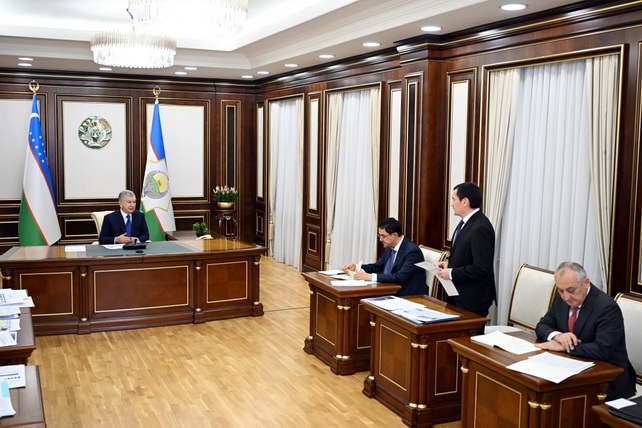
Freight and Passenger Transportation Volumes are Planned to Double In 2026–2030
Freight and Passenger Transportation Volumes are Planned to Double In 2026–2030
Tashkent, Uzbekistan (UzDaily.com) — President of the Republic of Uzbekistan Shavkat Mirziyoyev reviewed the performance of the railway sector and its development plans for the coming years.
It is noted that the large-scale transformations underway in the sector are already producing tangible results: for the first time, the industry ended last year with a net profit, and in the first nine months of 2025 this figure exceeded 800 billion soums.
Positive dynamics are also observed in transit and passenger transportation volumes, exports, and investments.
During the meeting, the need was emphasized not to be content with the successes achieved, but to continue improving the quality and volume of railway services in line with population and economic growth, while reducing costs in the sector.
Special attention was given to the implementation of artificial intelligence–based control systems covering the entire operational cycle—from tracking transportation to managing traffic flows, analyzing costs, and identifying potential losses. Experts estimate that this will reduce transportation costs by 20 percent.
Strategic plans for 2026–2030 envisage at least a twofold increase in passenger and freight transportation volumes. To achieve this goal, 151 kilometers of new railway lines will be constructed and 182 kilometers of existing lines electrified, 27 existing stations modernized, and 1,000 kilometers of railway tracks renewed.
Specifically, new electrified lines will be built on the routes Nurafshan–Pskent–Buka–Bekabad–Bayavut–Yangiyer and Khavast–Dashtabad, and sections Kumkurgan–Kudukli, Samarkand–Urgut, and Baytkurgan–Parkent will be electrified. The capacity of the routes Tashkent–Samarkand, Tukimachi–Angren, and Angren–Pap will also be increased.
For suburban transportation, 15 new routes will be opened to complement the existing 40, including Tashkent–Nurafshan–Ahangaran–Angren, Navoi–Zarafshan–Uchkuduk, Kagan–Namangan–Andijan–Margilan, Termez–Kumkurgan–Baysun–Darband, Nukus–Shavat–Urgench–Khiva, Jizzakh–Dustlik–Aydar-Arnasay, and Karshi–Shakhrisabz, creating comfortable conditions for daily commuting.
Expanding the high-speed railway network is a key priority. Particular attention is being given to the accelerated commissioning of the 102-kilometer Navoi–Bukhara line, which will significantly reduce travel time and costs for both passengers and freight.
As part of the rolling stock renewal program, 38 mainline and 50 shunting locomotives will be purchased from China, along with six high-speed electric trains in cooperation with the Korean company Hyundai Rotem.
The first high-speed train is scheduled to operate on the Tashkent–Urgench–Khiva route next year, reducing travel time from 14 to 7.5 hours. Additionally, 250 modern passenger cars will be manufactured, 23 intercity electric trains purchased, 10,000 freight wagons produced and over 6,000 refurbished, and 12 electric locomotives undergo major overhauls.
Special emphasis is placed on developing public-private partnership projects, implementing digital technologies and artificial intelligence, optimizing costs, and creating a more comfortable, safe, and reliable environment for passengers and businesses.
The meeting also reviewed the progress of the China–Kyrgyzstan–Uzbekistan railway construction.
The President highlighted the strategic importance of this route for enhancing transport connectivity in Central Asia and strengthening the country’s transit potential, instructing that high-quality construction standards be ensured.
Following the meeting, responsible officials were given specific instructions to ensure the timely and high-quality implementation of all railway modernization and expansion projects, improve transportation efficiency, and introduce innovative technologies across all areas of the sector.
#Shavkat Mirziyoyev